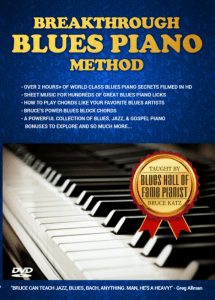Piano Improvisation – 1 Super Easy Improv Trick
 Need help with your piano improvisation? You’re in the right place.
Need help with your piano improvisation? You’re in the right place.
In the video below, Steve teaches you how you can take 1 simple lick and build cool sounding solos over many chords and progressions.
The sweet part is that you can use this lick over dozens of chord progression. Which is great if you want to start building some piano improvisation chops fast.
Take 4 minutes and watch the video below. I’ll break down this jazz piano improvisation concept for you.
Piano Improvisation Video Tutorial
4 Tips To Master This Piano Improvisation Single Lick Trick
Now that you’ve taken a few minutes to watch the video above, Let’s dive deep and explore how to get even more about this piano improvisation tips tutorial.
1. Why The Tones Of The I Chord Works On Any Chord
 The lick that Steve performs is based on two chord tones from Cmaj7: E and G.
The lick that Steve performs is based on two chord tones from Cmaj7: E and G.
The mind-blowing thing about this lick is that it will work on any chord in the key of C.
If you don’t believe me, try this: Play Steve’s lick over the chord progression below:
(4/4) | Dm7 | G7 | Cmaj7 | Fmaj7 | Bm7(b5) | E7 | Am7 | A7 |
| Dm7 | G7 | Cmaj7 | A7 | Dm7 | G7 | Cmaj7 | Cmaj7 |
Now, why might this be so? The notes of the lick always work as a chord tone.
Let’s break it down right here:
The Proof Of Why This Licks Works Over Every Chord
 E and G functions as:
E and G functions as:
- a 9th (E) and an 11th (G) for Dm7
- a 13th (E) and a root (G) for G7
- a 3rd (E) and a 5th (G) for Cmaj7
- a major 7th (E) and b9 (G) for Fmaj7
- an 11th (E) and a flat 6th (G) for Bm7(b5)
- a root (E) and a #11 (G) for E7
- a 5th (E) and a b7 (G) for Am7 or A7
Another thing that makes this lick work is that those chord tones are from the I chord.
The I chord is the primary chord that anchors everything in any particular key.
How The Simplest Scale Makes Piano Improvisation Magic
This is also one of the reasons why simple licks made from the pentatonic scale also work great over lots of different chord progressions.
And because the pentatonic scale sounds so familiar to us as improvisers we can use it to go in and outside the key. It’s an amazing device.
Here’s a cool example from the Jazz Improvisation Super System. Listen how simple repetitive melodies built from pentatonics can create spectacular sounds.
2. How To Use Chord Tones For Piano Improvisation
 The most important notes of any solo are the chord tones. They are the anchors that make any piano improvisation memorable.
The most important notes of any solo are the chord tones. They are the anchors that make any piano improvisation memorable.
Now here’s an interesting possibility: What if you can use the same rhythm and interval patterns of the original lick but apply them to other chord tones?
You can absolutely do that. Here are some examples of possibilities:
- When you’re in a Dm7 chord, try playing the same rhythmic pattern of Steve’s lick for A and C. They are the 5th and flat 7th of the Dm7 chord. Do you like this sound?
- Now, the next chord is G7. Why not try playing G7’s chord tones nearest to the A and C you played before?
- For your C chord, try playing G and B with the same rhythmic pattern.
- As for your A7 chord, play C# and E.
3. How To Use Chromatic Passing Tones Without Sounding Out Of Tune
 Let’s go back to Steve’s lick. He’s actually playing more than just the chord tones.
Let’s go back to Steve’s lick. He’s actually playing more than just the chord tones.
Whenever he plays the E, he plays the note a half step below the E just right before the beat. This is what we call a chromatic passing tone.
A chromatic passing tone is any note that is outside of the key a half step above or below a note found naturally in the key.
To achieve that nice bluesy effect, he just plays the Eb a fraction of a second before the beat and then slides the same finger off to E on the beat.
What I described is one of the most effective ways of using a chromatic passing tone.
Another example of how Steve uses chromatic passing tones is the next lick he uses.
In that lick, Steve plays the notes Eb-E-G-Gb-F-A over Dm7 and G7.
How A Half Step Can Make A Lick Shine
The odd thing about the lick is that he plays the Eb on the beat. It will sound strange when left alone over the Dm7. The minor 2nd interval formed between D and Eb sounds very tense.
So how does Steve solve that? He resolves the chromatic passing tone (Eb) by playing the E at the & of 1.
The key to using any chromatic passing note in piano improvisation is to resolve it to the neighboring chord tone.
This is the same thing that Steve does on the G-Gb-F-A passage of the lick. He resolves the Gb by playing F then A next. F and A works well as chord tones for Dm7 (3rd and 5th) and G7 (b7th and 9th).
 By the way, do you love the sound of these soulful grace notes and passing notes? Want to learn how to add them into your playing?
By the way, do you love the sound of these soulful grace notes and passing notes? Want to learn how to add them into your playing?
We have a whole chapter dedicated to this amazing technique as well as a lifetime of world class blues piano secrets inside the Breakthrough Blues Method.
Click here to access the whole epic course.
4. How To Create Variations For Sophisticated Piano Improvisation
The previous tips have examples of creating variations from a single lick.
Variations will make any piano improvisation interesting and engaging.
After all, it’s your goal as a pianist to always engage your audience. Never forget that.
So, to help you do that here are some more ways you can create interesting improv and solos.
10 More Piano Improvisation Techniques You Can Use
 Use chromatic approach patterns before playing a chord tone. For example, the G and Gb in the F of Steve’s 2nd lick form a chromatic approach pattern.
Use chromatic approach patterns before playing a chord tone. For example, the G and Gb in the F of Steve’s 2nd lick form a chromatic approach pattern.- Use different rhythms (syncopation, eighths, triplets, etc.)
- Reverse or invert the melody ala Baroque style (retrograde inversion).
- Side stepping.
- Coltrane sheet’s of sound lines where you run a scale and then a target note.
- Mixing of different chord tones, scales, licks, double stops, and superimposition of harmonies.
It’s critical that if you want to become a great improviser that you get in control of these devices. This is how you express yourself freely at the keys.
Does Your Piano Improvisation Entertain Or Bore Your Audience?
 Do you hate the way your improv sounds? Do you feel your solos are not compelling? Want to finally do something about it?
Do you hate the way your improv sounds? Do you feel your solos are not compelling? Want to finally do something about it?
It can cause a lot of stress to sit at the piano unguided and try to figure everything out by yourself.
Trust me I’ve been there before. It’s not fun or smart to learn this way…especially if you have a busy schedule.
How To Finally Build Killer Piano Solos
The good news is that we have done all the work for you. And we’ve made the learning process fun and easy. Even for newbies.
 We created the ultimate piano improvisation training program. We enlisted the help of piano improvisation genius David Garfield to show us his complete piano improvisation system.
We created the ultimate piano improvisation training program. We enlisted the help of piano improvisation genius David Garfield to show us his complete piano improvisation system.
In this action packed 6 hour course David literally takes us A-Z through his whole method.
Inside the Jazz Improvisation Super System, you’ll find techniques that will upgrade your piano improv skills immediately.
David’s stage-tested improv techniques will take your soloing skills to the next level and dazzle your friends and audience.
When you access the Jazz Improvisation Super System, you’ll discover:
- David’s trick for playing confidently over fast chord changes
- Simple scale hacks that let even total newbies play solos that sound fluid, creative, & musical.
- Rarely revealed harmony formulas from greats like Herbie Hancock, Chick Corea, McCoy Tyner, Horace Silver, Cedar Walton, & More.
- Great sounding piano improvisation techniques that can be applied to any genre (rock, blues, new age, country, jazz, gospel, pop, and more)
You can get a copy of The Jazz Improvisation Super System right here.
—-
Did this lesson help you improve your soloing skills? Do you like the way this simple piano improvisation technique sounds? If you have any questions feel free to leave a comment below.
As usual, I’m always here any time you need help achieving your musicianship goals. Thanks.
